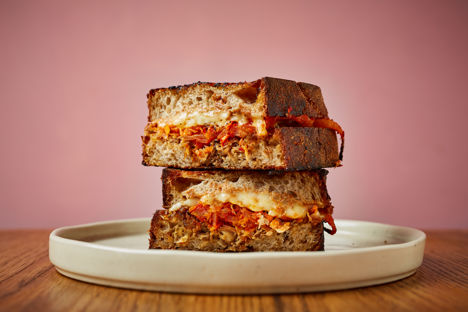While for many people outside of – and even within – Korea, the word ‘kimchi’ has come to exclusively mean spicy red pickled napa cabbage, kimchi is much more than one thing. The full name for this classic style of kimchi is actually baechu-kimchi, or napa cabbage kimchi. You can apply the same preserving method to a huge range of different vegetables – cucumbers, radishes, spring onions – to make them into kimchi too.This article will focus on baechu-kimchi, as it’s the most popular type of kimchi, and is really versatile. But it’s well worth seeking out different sorts of kimchi to try if you can find them.
Is kimchi spicy?
One of – if not the most – important ingredients in making baechu-kimchi is gochugaru, a bright red Korean chilli flakes. Although there are types of kimchi made without any spice at all – water kimchi, white kimchi etc. – baechu-kimchi normally has a little bit of heat because of the gochugaru.
Gochugaru is very mild however, much less intense than cayenne pepper or even Kashimiri chillies. It gives kimchi its beautiful deep red flavour, and has a particular flavour for which there is really no substitute. If you can’t source any, or want to make a completely chilli-free kimchi, we’d strongly recommend that you make some white kimchi rather than trying to swap in another type of chilli powder like smoked paprika or Aleppo pepper.
Is kimchi vegan?
Typically, kimchi contains some sort of fermented fish, so it isn’t usually vegan. Fish sauce and saeujeot (salty fermented shrimp) are the two most popular additions, but in Korea you can find kimchi made with everything from oysters to squid. In his book Of Cabbages and Kimchi, James Read recommends using aka miso or doenjang to bring some of the funk of fermented seafood to vegan and vegetarian kimchi.
How to make kimchi
Metric
Imperial
- 1 Chinese cabbage, or napa cabbage
- 1l water
- 80g of salt
- 4 spring onions, finely chopped
- 200g of daikon radish, peeled and julienned
- 25ml of fish sauce
- 2 tsp gochugaru
- 25g of shrimp paste
- 25 sugar
- 25g of garlic, ground to a paste
- 50g of ginger, ground to a paste
What do you eat with kimchi?
If you’re in Korea, anything! Kimchi is the perfect pairing to any Korean meal you can think of. Soups, stews, stir-fries, sandwiches – kimchi is the perfect accompaniment to so many different dishes it’s really hard to know where to begin.
If you’ve not had kimchi before, and just want to sample it, we’d recommend enjoying it with some plain, unsalted white rice and a boiled egg. If you love kimchi, and can’t get enough of it, kimchi pancakes and kimchi-jjigae are great uses for particularly funky aged kimchi.
For more of a fusion, we have recipes on the site for kimchi fritters, kimchi risotto and kimchi croquettes. The world is your kimchi-scented oyster.
Does kimchi go bad?
In short, as with anything, yes. Kimchi can go mouldy, sour, develop off-flavours etc. Properly fermented kimchi, however, will keep well for over a month. Its flavour will change, but not for the worse. It will simply become more funky and sour. More acidic, older kimchi is great in stir-fries or richer dishes where the extra funk helps cut through oily fish or rich pork. Freshly made kimchi is delicious with just rice and a light soup.
Get in touch
Please sign in or register to send a comment to Great British Chefs.



